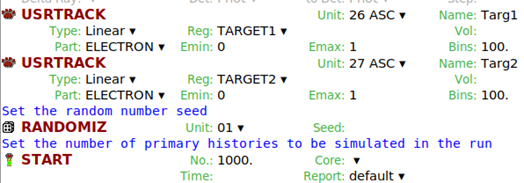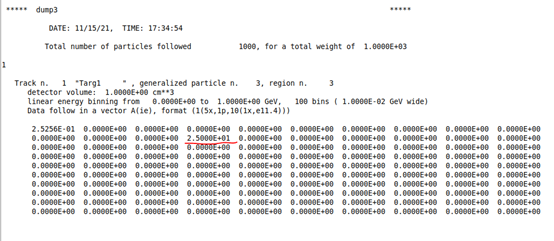Dear expert,
Since I am a new learner and not good at Source.f card, I use Specsour card to define two beam with the same energy (130 MeV) but opposite direction (one is positive and the other one is negative). The computation could be finished successfully.

- The first question is that I scored USRTRACK of the two target (the material is set to vacuum) and I check the output file while I was confused when I found that the max value of 25 is located in the energy bin of 130MeV-140MeV rather than max value of 50 located in the energy bin of 120MeV-130MeV as I expected, is there any point I made a mistake?


- Now I want to make a more complex simulation. The energy is not constant but follow energy spectra. I follow the guidance of the topic of [Sampling from energy spectra] (Sampling from energy spectra). The CERN-FLUKA-spectra-sampling.tgz (21.0 KB) is download and installed successfully and the example-input in the CERN-FLUKA-spectra-sampling.tgz could also be run successfully.
I add the energy spectra file of spec01 to my simulation. The code responds error message of Abort called from SPTCRD reason BEAM SPOT NONSENSE IN THIS CONTEXT Run stopped! STOP BEAM SPOT NONSENSE IN THIS CONTEXT.

cdmz20.flair (10.8 KB)
cdmz20.inp (10.4 KB)
Spec01.zip (414 Bytes)
I know the function of Specsour card is something like Source.f card. Dose that mean Specsour card conflicting with Source card defining energy spectra and they could not be used at the same time?
The .Flair file and the input file is attached. And I will appreciate if any expert could answer my questions.
Thank you.